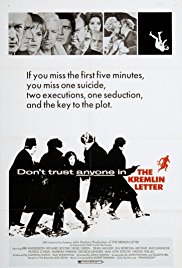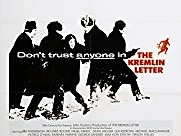The Kremlin Letter ** (1970, George Sanders, Richard Boone, Orson Welles, Bibi Andersson, Max von Sydow, Patrick O’Neal, Ronald Radd, Dean Jagger, Nigel Green, Barbara Parkins, Lila Kedrova) – Classic Movie Review 6507
John Huston’s 1970 Cold War spy thriller film The Kremlin Letter is an endearing farrago of a film from a legendary top-quality film-maker who should have been able to sort this mess out.
Co-writer/ co-producer/ director John Huston’s 1970 Cold War spy thriller film The Kremlin Letter is an endearing farrago of a film from a legendary top-quality film-maker who should have been able to sort all this out. But, no, it is still a mess. I love spy thrillers but this is ridiculous.
With Huston’s and Gladys Hill’s screenplay based on the 1966 best-seller novel by Noel Behn, the Hitchcock-style MacGuffin plot – about the recovery of a fake CIA treaty called The Kremlin Letter, binding America to Russia in destroying a future A-bomb-armed China – is unusually hard to swallow and more or less dispensable.
A network of Western spies from the recruits Charles Rone, a young Naval Intelligence officer with a photographic memory, to the CIA to accompany them on a covert operation in Moscow to recover The Kremlin Letter.
Huston considered the script ‘quite good, though in retrospect it was perhaps over-complicated.’
So instead of being able to enjoy a credible, indispensable story, we are left to concentrate on relishing a splendidly quirky cast (most of them alas no longer with us), also of top quality, doing outrageously amusing turns. Poor old George Sanders in drag is alone worth the price of admission as Warlock. However Patrick O’Neal is the weak link in the lead role of Charles Rone, though, to be fair, he is about the only actor who seems to be taking it seriously.
Also in the exceptionally strong cast are Richard Boone, Orson Welles, Bibi Andersson, Max von Sydow, Patrick O’Neal, Ronald Radd, Dean Jagger, Nigel Green, Barbara Parkins, Lila Kedrova, Micheál MacLiammóir, Sandor Elès, Niall MacGinnis, Raf Vallone, Anthony Chinn, Guy Deghy, Fulvia Ketoff, Vonetta McGee, Marc Lawrence, Cyril Shaps, Christopher Sandford, Hans Maria Pravda, George Pravda, Ludmilla Dudarova, Dimitri Tamarova, and Victor Beaumont.
Not sparing his own blushes, Huston himself appears as the Admiral.
Huston’s thriller is violent, adult stuff for its day, with all those qualities that he said were just coming into fashion in 1970 – violence, lurid sex and drugs.
Huston later pointed out another plus point to his movie. ‘It was extremely well photographed – there was a virtuosity, a shine to it.’ It is shot by Ted Scaife, produced by Carter DeHaven, Sam Wiesenthal and John Huston, scored by Robert Drasnin and designed by Ted Haworth.
The Kremlin Letter was filmed in Italy, Mexico, the US and Helsinki, Finland, standing in for Moscow.
Aspects of the film recall Huston’s earlier triumphs The Asphalt Jungle (1950) and The Maltese Falcon (1941). He went on to make The MacKintosh Man (1973) in similar vein.
It was admired by Jean-Pierre Melville, who called it masterly.
Behn based his novel on his experiences in working for the US Army’s Counter Intelligence Corps. The only other film of his work is The Brink’s Job (1978), based on Behn’s book Big Stick Up at Brink’s.
© Derek Winnert 2018 Classic Movie Review 6507
Check out more reviews on http://derekwinnert.com



